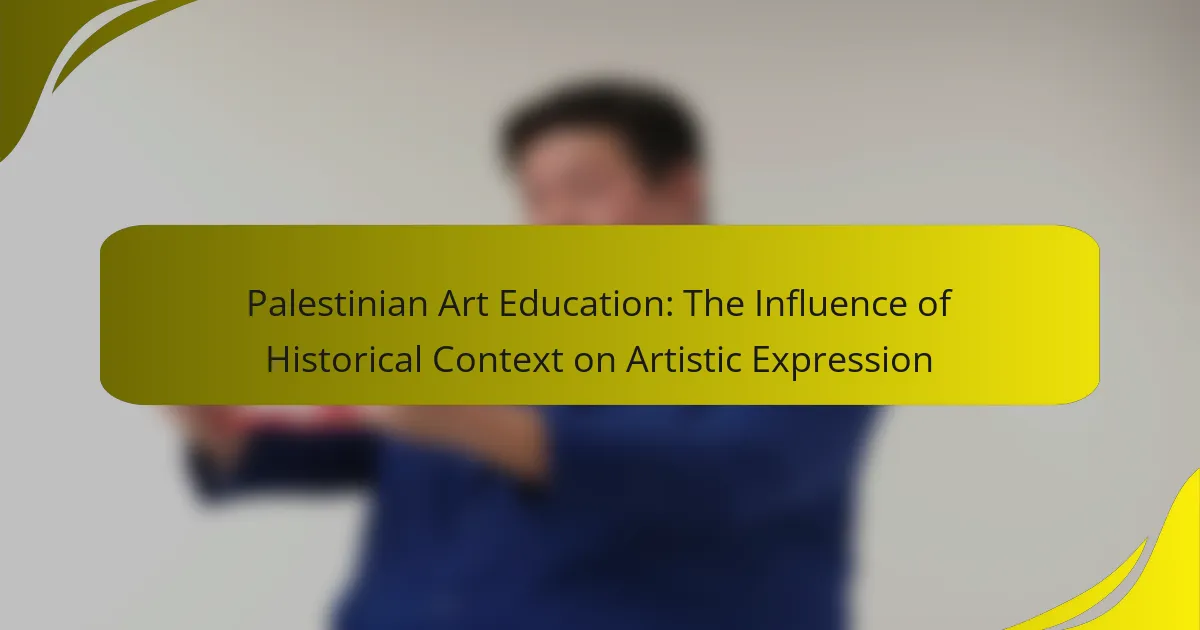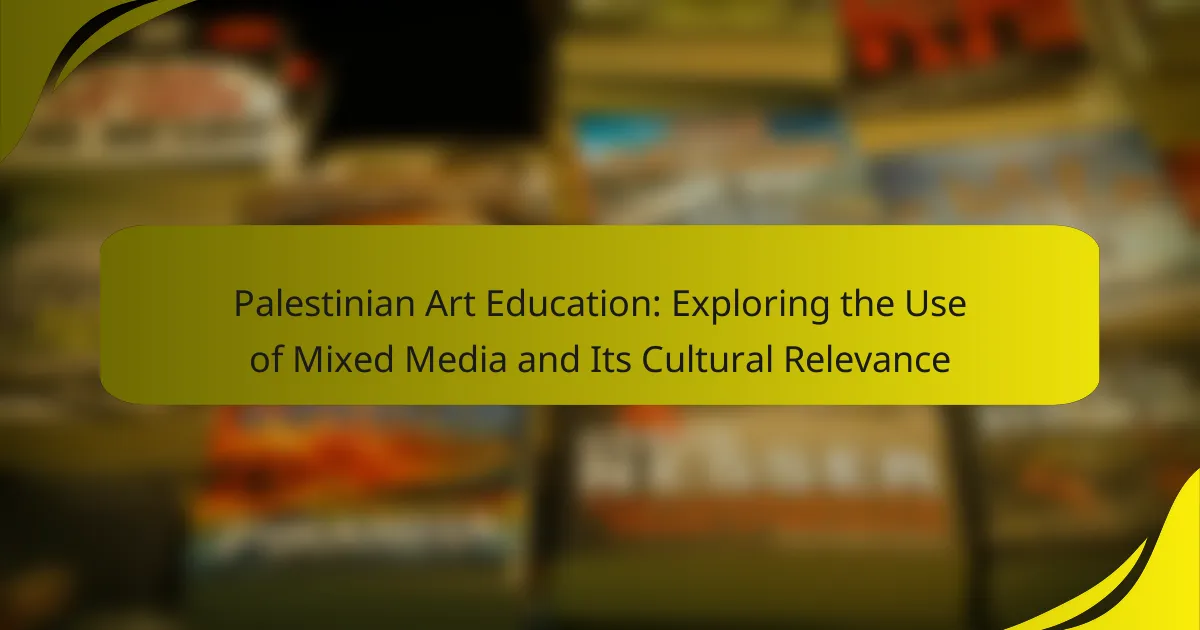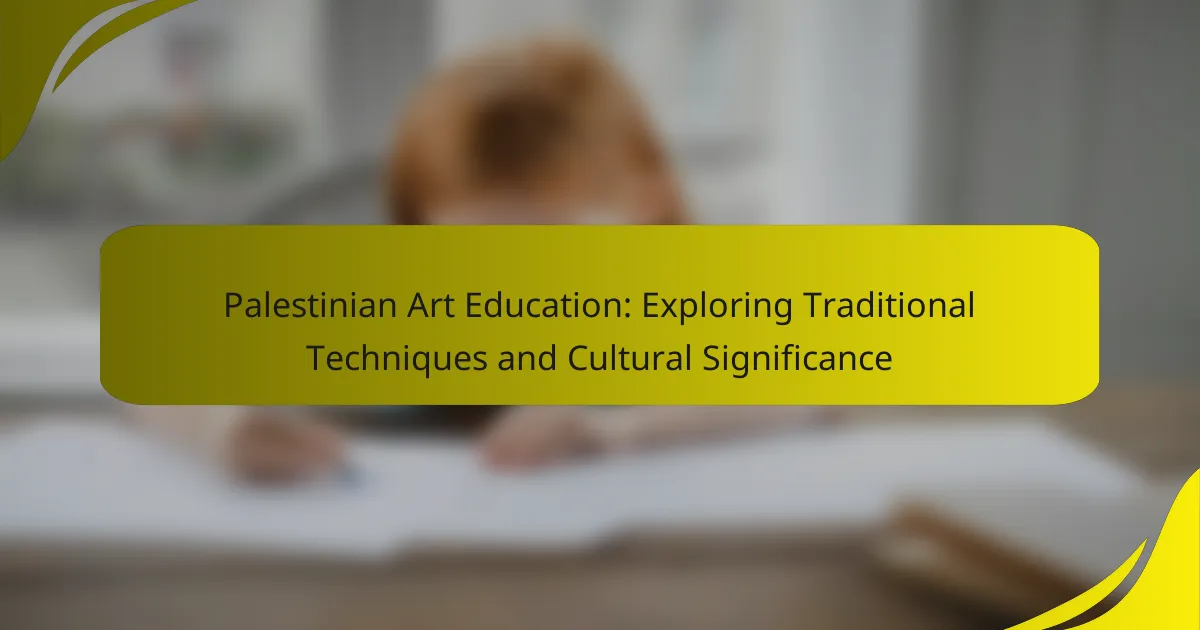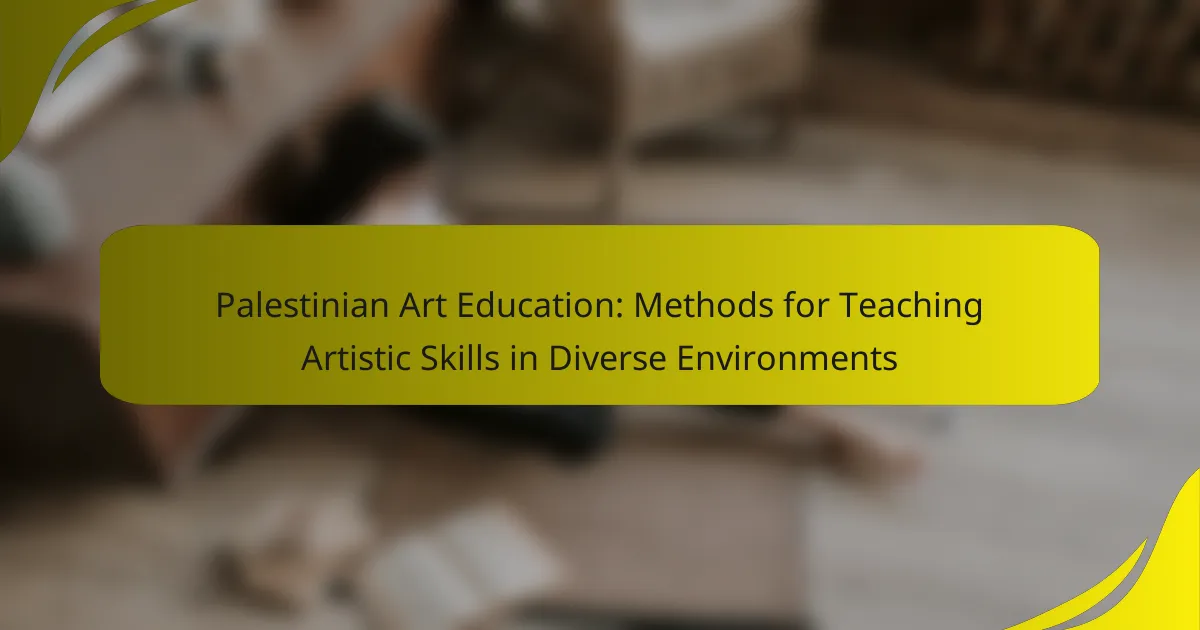Palestinian Art Education encompasses the structured teaching and learning of art practices within Palestine, blending traditional art forms with modern artistic expressions. This educational framework aims to preserve cultural heritage while encouraging creativity and innovation among students. Various programs in visual arts, music, and performing arts emphasize the role of art in expressing social and political narratives. Educators face challenges such as political instability, limited resources, and cultural restrictions, which impact their ability to integrate modern techniques and foster artistic growth. The article examines effective teaching strategies, including hands-on workshops and collaboration with local artists, to enhance students’ understanding and appreciation of Palestinian art.
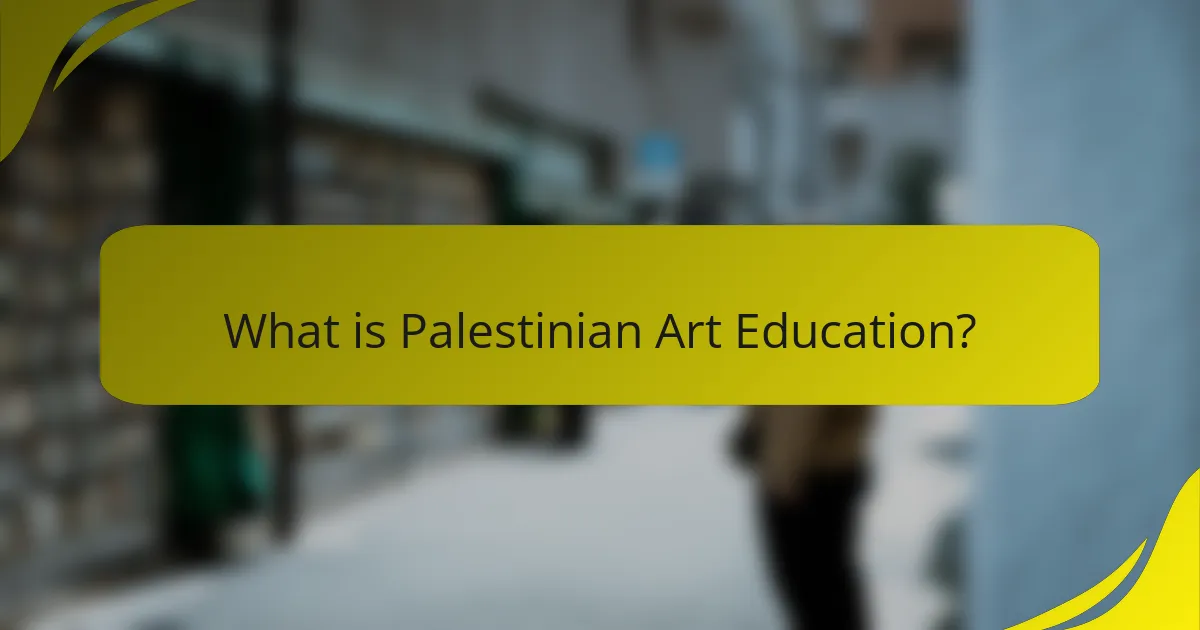
What is Palestinian Art Education?
Palestinian Art Education refers to the structured teaching and learning of art practices within the Palestinian context. It encompasses the exploration of traditional Palestinian art forms alongside modern artistic expressions. This education aims to preserve cultural heritage while fostering creativity and innovation among students. Institutions in Palestine offer various programs focusing on visual arts, music, and performing arts. These programs often emphasize the significance of art in expressing social and political narratives. The integration of modern techniques with traditional methods is a key component of the curriculum. Palestinian artists and educators advocate for this approach to enrich the artistic landscape. This educational framework is crucial for nurturing a new generation of artists who reflect their cultural identity.
How has Palestinian Art Education evolved over time?
Palestinian Art Education has evolved significantly over time. Initially, it focused on traditional techniques and cultural heritage. Artists emphasized local themes and historical narratives. In the late 20th century, contemporary influences began to emerge. This included modern art movements and international styles. Educational institutions adapted curricula to incorporate these changes. Workshops and exhibitions showcased a blend of traditional and modern art. Today, Palestinian Art Education promotes innovation while preserving cultural identity. The integration of diverse styles reflects the dynamic nature of Palestinian society.
What historical influences shaped Palestinian Art Education?
Palestinian Art Education has been shaped by various historical influences, including cultural heritage, colonialism, and socio-political struggles. The rich cultural heritage of Palestine, including Islamic and Byzantine art, laid foundational artistic principles. Colonialism introduced Western artistic techniques and education systems, which impacted local art practices. The ongoing socio-political struggles have also influenced themes and expressions within Palestinian art. Notable events, such as the Nakba in 1948, have led to a focus on identity and resistance in artistic expression. These factors collectively contribute to the unique landscape of Palestinian Art Education today.
How do cultural factors impact the evolution of art education in Palestine?
Cultural factors significantly influence the evolution of art education in Palestine. The rich historical heritage shapes artistic expression and curriculum development. Traditional Palestinian art forms, such as embroidery and pottery, are integrated into educational programs. This integration fosters a sense of identity and continuity among students. Additionally, cultural narratives around resistance and resilience inform artistic themes. The impact of socio-political contexts also directs the focus of art education. For instance, the ongoing conflict influences the subject matter and mediums used. This dynamic creates a unique blend of modern and traditional art practices within educational settings. Overall, cultural factors are central to shaping the pedagogical approaches in Palestinian art education.
What are the core components of Palestinian Art Education?
The core components of Palestinian Art Education include cultural heritage, artistic techniques, and community engagement. Cultural heritage emphasizes the historical and social context of Palestinian identity. Artistic techniques involve both traditional methods, such as embroidery and pottery, and modern practices, like digital art and painting. Community engagement fosters collaboration among artists and students, creating a supportive environment for artistic expression. These components work together to promote a comprehensive understanding of art within the Palestinian context.
Which traditional techniques are taught in Palestinian art schools?
Palestinian art schools teach various traditional techniques, including calligraphy, pottery, and embroidery. Calligraphy is a revered art form, emphasizing intricate designs and cultural significance. Pottery techniques often involve hand-building and glazing methods, reflecting local heritage. Embroidery is practiced through specific patterns that tell stories and represent identity. These techniques are integral to preserving Palestinian cultural heritage. Art schools in the region focus on these methods to maintain traditional artistry while integrating modern styles. This educational approach fosters a deeper understanding of Palestinian history and artistic expression.
How are modern artistic styles incorporated into the curriculum?
Modern artistic styles are incorporated into the curriculum through various teaching methods. Educators utilize project-based learning to engage students in contemporary art practices. This approach allows students to explore their creativity while using modern techniques. Workshops and collaborative projects often feature current artistic trends. Students analyze and critique contemporary artworks to understand their context. Field trips to galleries and exhibitions expose students to modern art. Integration of technology in art-making enhances students’ skills in digital media. These methods align with educational standards promoting creativity and critical thinking.
Why is the integration of modern and traditional styles important?
The integration of modern and traditional styles is important for cultural preservation and innovation. Combining these styles allows artists to honor their heritage while embracing contemporary techniques. This fusion creates a unique artistic expression that resonates with diverse audiences. It also encourages dialogue between generations, bridging the gap between historical and modern perspectives. Furthermore, this integration can lead to new art forms that reflect current societal issues. In Palestinian art, this approach is essential for maintaining identity amidst globalization. The blending of styles enriches the artistic landscape and fosters creativity.
What benefits does this integration provide to students?
The integration of modern and traditional styles in Palestinian art education provides students with enhanced creative expression. This approach allows students to explore diverse artistic techniques. They learn to appreciate cultural heritage while embracing contemporary influences. Students develop critical thinking skills by analyzing different art forms. This integration fosters innovation, encouraging students to create unique artworks. Additionally, it promotes cultural awareness and identity. Research indicates that students engaged in diverse art practices show improved problem-solving abilities. Overall, this integration enriches the educational experience and prepares students for a dynamic artistic landscape.
How does blending styles reflect Palestinian identity?
Blending styles in Palestinian art reflects the diverse cultural influences and historical experiences of the Palestinian identity. This integration of modern and traditional elements showcases the resilience and adaptability of Palestinian artists. For instance, the use of traditional embroidery motifs alongside contemporary painting techniques emphasizes a connection to heritage while engaging with global art movements. Artists like Sliman Mansour and Muna Abu Nassar exemplify this fusion, incorporating folkloric themes into modern aesthetics. This approach not only preserves cultural narratives but also addresses contemporary social and political issues. The blending of styles ultimately serves as a visual representation of the Palestinian struggle and identity, fostering a sense of unity and continuity among the community.
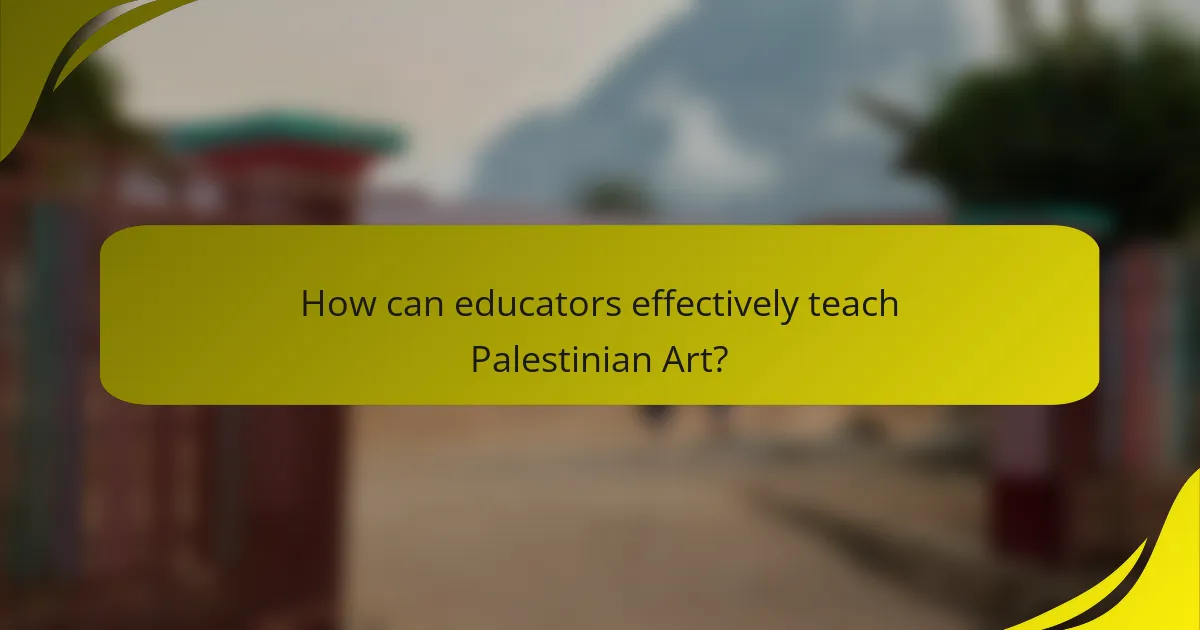
How can educators effectively teach Palestinian Art?
Educators can effectively teach Palestinian Art by incorporating both historical context and contemporary practices. Understanding the cultural significance of Palestinian Art is essential. Educators should introduce students to key artists and movements that represent Palestinian identity. Utilizing various mediums, such as painting, sculpture, and digital art, can engage students creatively.
Hands-on workshops allow students to experiment with traditional techniques, such as embroidery and mosaic. Field trips to art galleries or cultural centers can enhance students’ appreciation for Palestinian Art. Collaborating with local artists provides students with real-world insights.
Incorporating discussions about the socio-political aspects of Palestinian Art fosters critical thinking. Utilizing multimedia resources can make lessons more dynamic and relatable. By blending traditional and modern styles, educators can create a comprehensive curriculum that honors Palestinian heritage.
What teaching methods are most effective for integrating styles?
Collaborative learning and project-based learning are the most effective teaching methods for integrating styles. Collaborative learning encourages students to work together, sharing diverse perspectives and techniques. This method fosters creativity and innovation by allowing students to blend modern and traditional styles. Project-based learning engages students in hands-on activities that require the application of various artistic techniques. This approach helps students understand the historical context and significance of both modern and traditional styles. Research shows that students who participate in collaborative and project-based learning demonstrate higher levels of engagement and retention in art education.
How can hands-on experiences enhance learning in art education?
Hands-on experiences enhance learning in art education by promoting active engagement and deeper understanding. Students develop practical skills through direct interaction with materials. This method fosters creativity and self-expression. Research indicates that tactile experiences improve memory retention. For example, a study by the National Art Education Association found that students who participate in hands-on activities score higher in art assessments. Engaging in projects allows learners to apply theoretical concepts in real-world contexts. This approach also encourages collaboration and communication among peers. Overall, hands-on experiences make art education more dynamic and effective.
What role does collaborative learning play in art education?
Collaborative learning enhances art education by fostering creativity and critical thinking. It allows students to share ideas and techniques. This interaction leads to diverse artistic expressions. Collaborative projects encourage teamwork and communication skills. Research shows that students engaged in collaborative learning perform better academically. A study by Johnson and Johnson (2009) indicates that cooperative learning improves student achievement and interpersonal relationships. In art, this approach helps students appreciate different perspectives. Ultimately, collaborative learning enriches the educational experience in art education.
What resources are available for art educators in Palestine?
Art educators in Palestine have access to various resources. These include local art organizations that provide training and workshops. Institutions like the Al-Quds University offer art education programs. Additionally, NGOs such as the Palestinian Art Court support artists and educators. Online platforms also provide educational materials and networking opportunities. Collaborative projects with international institutions enhance resource availability. These resources collectively support the development of art education in Palestine.
Which organizations support Palestinian art education?
Organizations that support Palestinian art education include the Al-Quds University Art Department and the Palestinian Museum. These institutions promote artistic expression and cultural heritage. They provide resources, workshops, and exhibitions for aspiring artists. The Al-Quds University Art Department focuses on integrating traditional and contemporary techniques. The Palestinian Museum aims to preserve and showcase Palestinian art and history. Additionally, organizations like Art for All and the Palestinian Art Court also contribute to art education initiatives. They foster creativity and support local artists in their development.
What materials and tools are essential for teaching art?
Essential materials and tools for teaching art include a variety of art supplies and equipment. Basic supplies consist of pencils, erasers, and sketchbooks for drawing. Paints, brushes, and palettes are necessary for painting techniques. Canvas and paper of various textures support different artistic styles. Tools like scissors, glue, and craft knives assist in collage and mixed media projects. Easels provide support for canvases during painting. Digital tools, such as tablets and software, are increasingly important for modern art education. Access to reference materials, including art history books and online resources, enriches the learning experience. These materials enable students to explore both modern and traditional art techniques effectively.
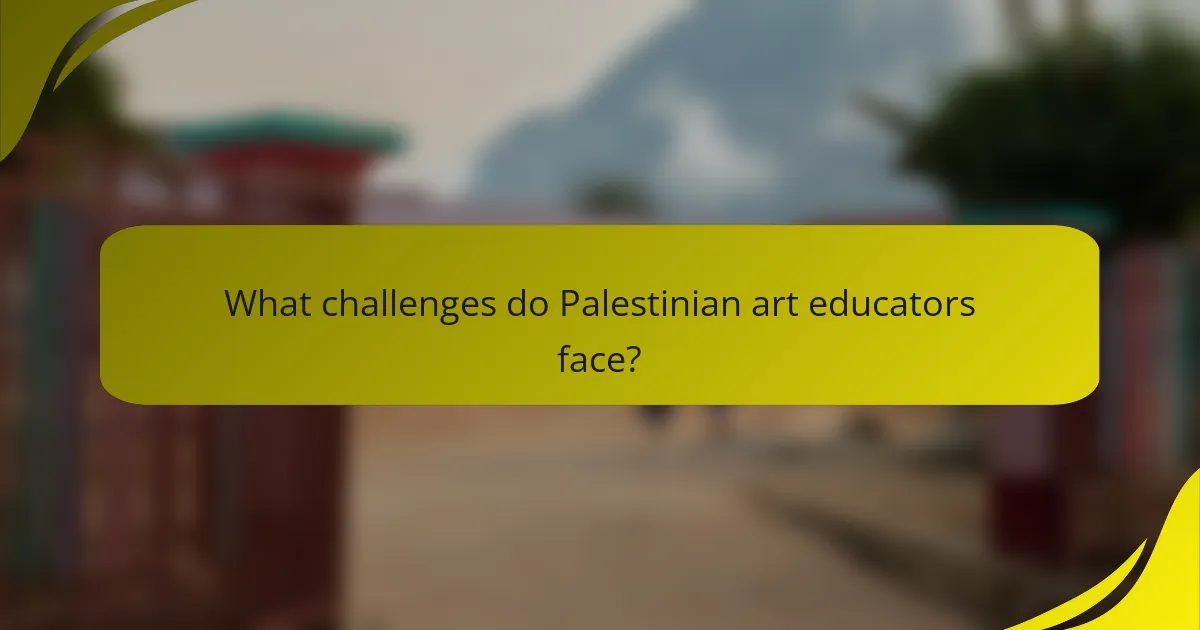
What challenges do Palestinian art educators face?
Palestinian art educators face significant challenges due to political instability and limited resources. The ongoing conflict restricts access to materials and safe teaching environments. Many educators lack formal training and professional development opportunities. This situation hampers their ability to innovate and integrate modern techniques. Additionally, cultural restrictions can limit artistic expression. Economic hardships further reduce funding for art programs. These factors collectively hinder the growth and effectiveness of art education in Palestine.
How do socio-political factors affect art education in Palestine?
Socio-political factors significantly affect art education in Palestine. The ongoing conflict and occupation create instability in educational environments. Limited resources hinder access to quality art materials and facilities. Political restrictions impact curriculum development and artistic expression. Many educators face challenges in promoting creativity due to societal pressures. Cultural identity plays a crucial role in shaping art education. Students often use art to express resistance and resilience. Research indicates that art serves as a means of coping with trauma in conflict zones.
What are the implications of limited resources on art education?
Limited resources significantly hinder art education. Access to materials, tools, and facilities is crucial for effective learning. Without adequate supplies, students struggle to fully engage in creative processes. Research indicates that schools with fewer resources see lower student participation in art programs. For example, a study by the National Art Education Association found that underfunded programs often lack essential supplies, leading to diminished student outcomes. Furthermore, limited funding restricts the ability to hire qualified instructors. This results in a lack of diverse teaching methods and exposure to various art forms. Overall, resource limitations create barriers that diminish the quality and accessibility of art education.
What strategies can help overcome these challenges?
In Palestinian art education, strategies to overcome challenges include incorporating diverse teaching methods. These methods can blend traditional techniques with modern artistic practices. Engaging students through hands-on workshops fosters creativity and skill development. Collaborating with local artists enhances cultural relevance and authenticity. Utilizing digital platforms expands access to resources and global perspectives. Providing mentorship opportunities connects students with experienced artists. Encouraging community involvement strengthens support for art initiatives. These strategies collectively address the barriers faced in integrating modern and traditional styles in Palestinian art education.
How can community engagement enhance art education initiatives?
Community engagement can significantly enhance art education initiatives by fostering collaboration and support. It creates opportunities for local artists to participate in educational programs. This involvement enriches the curriculum with diverse perspectives and techniques. Engaged communities also provide resources, funding, and venues for art exhibitions. Research shows that community-based art projects improve student motivation and creativity. A study by the Arts Education Partnership found that such initiatives increase student engagement and achievement in schools. Through collaboration, art education becomes more relevant and impactful for students. Engaging the community ensures that art education reflects local culture and history.
What role do online platforms play in promoting Palestinian art education?
Online platforms significantly enhance Palestinian art education by providing accessible resources and global exposure. They facilitate virtual galleries, workshops, and classes that connect artists and educators. These platforms allow for the sharing of traditional and modern techniques among diverse audiences. Social media channels enable artists to showcase their work and narratives, fostering cultural exchange. Online courses offer structured learning opportunities for students in various locations. Research indicates that digital engagement increases participation in art education initiatives. This accessibility supports the preservation and innovation of Palestinian artistic heritage.
What best practices can enhance the teaching of Palestinian art?
Incorporating hands-on workshops can enhance the teaching of Palestinian art. These workshops allow students to engage directly with traditional techniques. Utilizing local artists as instructors can provide authentic insights into the cultural context. Integrating historical narratives into lessons can deepen students’ understanding of the art’s significance. Encouraging collaborative projects fosters community engagement and creativity among students. Utilizing digital platforms can broaden access to resources and diverse artistic expressions. Incorporating field trips to galleries and cultural sites can provide real-world connections to the art. Lastly, promoting critical discussions about the themes in Palestinian art can enhance students’ analytical skills.
How can educators foster creativity and innovation among students?
Educators can foster creativity and innovation among students by implementing project-based learning. This approach encourages students to engage in hands-on projects that require critical thinking and problem-solving. Collaborative group work allows students to share diverse perspectives and ideas. Incorporating technology into lessons can enhance creative expression through digital tools. Providing a safe space for experimentation encourages students to take risks without fear of failure. Integrating traditional and modern art techniques in lessons can inspire unique artistic expressions. Research shows that environments that promote autonomy lead to higher levels of creativity. A study by Amabile (1996) highlights the importance of intrinsic motivation in fostering innovation.
What tips can help integrate technology into art education effectively?
Incorporating technology into art education can enhance creativity and engagement. Use digital tools for creating and sharing artwork. Software like Adobe Creative Suite allows for advanced design techniques. Online platforms can facilitate collaboration among students. Virtual reality can provide immersive art experiences. Incorporate social media for showcasing student work. Use digital portfolios to track student progress. Research indicates that technology integration improves student motivation and learning outcomes. A study by the International Society for Technology in Education found that 78% of teachers reported enhanced student engagement through technology use.
Palestinian Art Education encompasses the structured teaching of art practices within Palestine, integrating traditional and modern techniques to preserve cultural heritage while fostering creativity. This educational framework evolves through historical influences, socio-political contexts, and community engagement, emphasizing the significance of art in expressing identity and resistance. Core components include cultural heritage, artistic techniques, and collaborative learning, while challenges such as limited resources and political instability impact its effectiveness. Strategies for enhancing art education involve hands-on experiences, mentorship, and the incorporation of technology, ensuring a comprehensive understanding of both traditional and contemporary artistic expressions.
